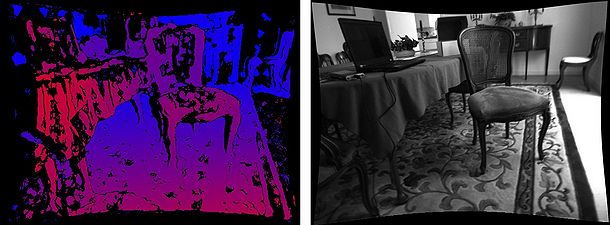Example Stereo Disparity
Stereo Disparity
Shows how to compute dense disparity between two rectified stereo images. BoofCV provides two different rectangular region based algorithms and noise reduction techniques targeted at real-time processing. Stereo vision can be difficult to get right, so please read all JavaDoc and cited papers. Dense stereo disparity is a computationally expensive and is likely to require a reduction in image size to achieve truly real-time performance.
For visualization purposes the disparity is encoded using a color histogram. Hotter colors indicate closer objects while cooler objects indicate objects that are farther away. Cameras must be accurate calibrated or else an error of a few pixels will drastically degrade performance. A common preprocessing step is to run a Laplacian of Gaussian edge detector across the image to provide invariance to lighting conditions. This was not done below because the cameras have their gain synchronized.
Example File: ExampleStereoDisparity.java]
Concepts:
- Stereo Vision
- Disparity
- Rectification
Related Examples:
Example Code
/**
* The disparity between two stereo images is used to estimate the range of objects inside
* the camera's view. Disparity is the difference in position between the viewed location
* of a point in the left and right stereo images. Because input images are rectified,
* corresponding points can be found by only searching along image rows.
*
* Values in the disparity image specify how different the two images are. A value of X indicates
* that the corresponding point in the right image from the left is at "x' = x - X - minDisparity",
* where x' and x are the locations in the right and left images respectively. An invalid value
* with no correspondence is set to a value more than (max - min) disparity.
*
* @author Peter Abeles
*/
public class ExampleStereoDisparity {
/**
* Computes the dense disparity between between two stereo images. The input images
* must be rectified with lens distortion removed to work! Floating point images
* are also supported.
*
* @param rectLeft Rectified left camera image
* @param rectRight Rectified right camera image
* @param minDisparity Minimum disparity that is considered
* @param maxDisparity Maximum disparity that is considered
* @return Disparity image
*/
public static ImageUInt8 denseDisparity( ImageUInt8 rectLeft , ImageUInt8 rectRight ,
int minDisparity , int maxDisparity )
{
// A slower but more accuracy algorithm is selected
// All of these parameters should be turned
StereoDisparity<ImageUInt8,ImageUInt8> disparityAlg =
FactoryStereoDisparity.regionWta(DisparityAlgorithms.RECT_FIVE,
minDisparity, maxDisparity, 3, 3, 20, 1, 0.2, ImageUInt8.class);
// process and return the results
disparityAlg.process(rectLeft,rectRight);
return disparityAlg.getDisparity();
}
/**
* Rectified the input images using known calibration.
*/
public static void rectify( ImageUInt8 origLeft , ImageUInt8 origRight ,
StereoParameters param ,
ImageUInt8 rectLeft , ImageUInt8 rectRight )
{
// Compute rectification
RectifyCalibrated rectifyAlg = RectifyImageOps.createCalibrated();
Se3_F64 leftToRight = param.getRightToLeft().invert(null);
// original camera calibration matrices
DenseMatrix64F K1 = UtilIntrinsic.calibrationMatrix(param.getLeft(), null);
DenseMatrix64F K2 = UtilIntrinsic.calibrationMatrix(param.getRight(),null);
rectifyAlg.process(K1,new Se3_F64(),K2,leftToRight);
// rectification matrix for each image
DenseMatrix64F rect1 = rectifyAlg.getRect1();
DenseMatrix64F rect2 = rectifyAlg.getRect2();
// New calibration matrix,
DenseMatrix64F rectK = rectifyAlg.getCalibrationMatrix();
// Adjust the rectification to make the view area more useful
RectifyImageOps.fullViewLeft(param.left, rect1, rect2, rectK);
// undistorted and rectify images
ImageDistort<ImageUInt8> imageDistortLeft =
RectifyImageOps.rectifyImage(param.getLeft(), rect1, ImageUInt8.class);
ImageDistort<ImageUInt8> imageDistortRight =
RectifyImageOps.rectifyImage(param.getRight(), rect2, ImageUInt8.class);
imageDistortLeft.apply(origLeft, rectLeft);
imageDistortRight.apply(origRight, rectRight);
}
public static void main( String args[] ) {
String calibDir = "../data/applet/calibration/stereo/Bumblebee2_Chess/";
String imageDir = "../data/applet/stereo/";
StereoParameters param = BoofMiscOps.loadXML(calibDir + "stereo.xml");
// load and convert images into a BoofCV format
BufferedImage origLeft = UtilImageIO.loadImage(imageDir + "chair01_left.jpg");
BufferedImage origRight = UtilImageIO.loadImage(imageDir+"chair01_right.jpg");
ImageUInt8 distLeft = ConvertBufferedImage.convertFrom(origLeft,(ImageUInt8)null);
ImageUInt8 distRight = ConvertBufferedImage.convertFrom(origRight,(ImageUInt8)null);
// rectify images
ImageUInt8 rectLeft = new ImageUInt8(distLeft.width,distLeft.height);
ImageUInt8 rectRight = new ImageUInt8(distRight.width,distRight.height);
rectify(distLeft,distRight,param,rectLeft,rectRight);
// compute disparity
ImageUInt8 disparity = denseDisparity(rectLeft,rectRight,10,60);
// show results
BufferedImage visualized = VisualizeImageData.disparity(disparity, null,10,60,0);
ShowImages.showWindow(rectLeft,"Rectified");
ShowImages.showWindow(visualized,"Disparity");
}
}
